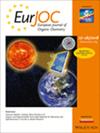6‐三氟甲基螺[3.3]庚烷结构块的合成与理化表征
IF 2.7
3区 化学
Q2 CHEMISTRY, ORGANIC
引用次数: 0
摘要
开发了一种实用的6‐(三氟甲基)螺[3.3]庚烷衍生构建块的合成方法。从市售的环丁酮衍生物开始,在一次运行中以0.5 kg的规模制备关键构建块- 1,1‐双(溴甲基)‐3‐(三氟甲基)环丁烷。螺旋[3.3]庚烷核心的进一步构建是通过TosMIC或丙二酸二酯的双烷基化达到120克的规模。简单的官能团转化提供了广泛的单功能和双功能螺旋[3.3]庚烷衍生的构建模块,包括醇,胺,硼酸酯,羧酸和氨基酸在克到多克的尺度上。物理化学性质(即酸度pKa和亲脂性LogP)通过实验测定,并与非氟、单氟和宝石二氟化合物以及环己烷和环庚烷衍生物进行了比较。所得化合物的空间结构通过X射线衍射研究和出口矢量图分析进行了表征。本文章由计算机程序翻译,如有差异,请以英文原文为准。
![Synthesis and Physicochemical Characterization of 6‐Trifluoromethyl Spiro[3.3]Heptane Building Blocks](https://img.booksci.cn/booksciimg/2025-8/108321748311792331343.jpg)
Synthesis and Physicochemical Characterization of 6‐Trifluoromethyl Spiro[3.3]Heptane Building Blocks
A practical synthesis of 6‐(trifluoromethyl)spiro[3.3]heptane‐derived building blocks is developed. Starting from a commercially available cyclobutanone derivative, a key building block—1,1‐bis(bromomethyl)‐3‐(trifluoromethyl)cyclobutane—is prepared on a 0.5 kg scale in a single run. Further construction of the spiro[3.3]heptane core is achieved via double alkylation of TosMIC or malonate diester on up to 120 g scale. Simple functional group transformation provides access to a wide range of mono‐ and bifunctional spiro[3.3]heptane‐derived building blocks, including alcohols, amines, boronate esters, carboxylic acids, and amino acids on a gram to multigram scale. Physicochemical properties (i.e., acidity pKa and lipophilicity LogP) are experimentally determined and compared to those for non‐, mono‐, and gem‐difluorinated counterparts, as well as cyclohexane and cycloheptane derivatives. The spatial structure of the obtained compounds is evaluated by X‐ray diffraction studies and characterized by exit vector plot analysis.
求助全文
通过发布文献求助,成功后即可免费获取论文全文。
去求助
来源期刊
CiteScore
5.40
自引率
3.60%
发文量
752
审稿时长
1 months
期刊介绍:
The European Journal of Organic Chemistry (2019 ISI Impact Factor 2.889) publishes Full Papers, Communications, and Minireviews from the entire spectrum of synthetic organic, bioorganic and physical-organic chemistry. It is published on behalf of Chemistry Europe, an association of 16 European chemical societies.
The following journals have been merged to form two leading journals, the European Journal of Organic Chemistry and the European Journal of Inorganic Chemistry:
Liebigs Annalen
Bulletin des Sociétés Chimiques Belges
Bulletin de la Société Chimique de France
Gazzetta Chimica Italiana
Recueil des Travaux Chimiques des Pays-Bas
Anales de Química
Chimika Chronika
Revista Portuguesa de Química
ACH—Models in Chemistry
Polish Journal of Chemistry.

 求助内容:
求助内容: 应助结果提醒方式:
应助结果提醒方式:


